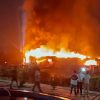Goa is abuzz with excitement as vintage bike and car owners, users, collectors and fans are decking […]

FENI for all FROM KIDs TO GRANDPAS!
April 03- April 09, 2021, In the News April 2, 2021DELICIOUS: Uraak is the first distillation of the cashew apple and is a very popular drink during hot summer days. Unfortunately, there is no consistency in its distillation and can send you to the moon if you get the wrong batch.
By Arvind Pinto
Feni is the most popular drink in Goa and is used by all sections of the population. Children are introduced to feni at a very early age as it has medicinal properties. The Government of India like the Portuguese colonial regime has kept the taxes on feni very low to encourage its consumption. With the GI tag feni can now compare itself with other foreign drinks like the Chinese rice wine maiti.
FOR most visitors, if it’s Goa, then it is feni. For this local drink drunk by almost all locals is worth a try and possibly one would in time acquire a taste for it. Feni – sometimes spelled as fenno, fenim or fenny, is a local alcohol that has been distilled in Goa from the times when the Portuguese introduced the cashew plant in Goa from Brazil where in grows abundantly. Early Portuguese records about the Common Era year 1740 suggest that local Goans were using cashew to distill feni.
Feni is made from several plants but today in Goa, there are basically two main types of feni – kaju feni made from cashews apples or maad – distilled from the flowers of the palm tree. Coconut and palm trees are grown abundantly on the coastline, whereas cashew as we have noted was introduced into India by the Portuguese from Brazil.
Feni in Goa is still a cottage industry and prepared in villages by families that have been in the tradition for generations. Today with the growing demand there are several big distillers who now prepare this alcohol commercially. The season for the preparation of kaju feni begins during the summer, this is when the cashew apple ripens and falls to the ground.
Interestingly, all good kaju feni is prepared from fallen cashew apple – during the summer months of March, April and May, they are collected and at first de-seeded. The cashew seeds are sold as nuts. The the cashews are placed in a ‘colmbi’, a large basin like cavity in a rock. Traditional kaju feni is prepared on the top of a hillock. I remember when I was young, I would wander up the hillock behind our ancestral house to watch the villagers who wandered around picking cashews and bringing them to the ‘Colombia’.
Much of the stomping is done manually, where the Goenkars stomp the cashews by legs and then gather the fruit into a mound, placing a stone over it to extract the remaining juice. Today much of the traditional stomping by legs has been replaced by a ‘pingre’ which is a sieve that presses the cashews to extract the juice. This is then passed through a vine and stored in large earthen pots called a ‘kodem.’ These pots are then stored in pits out in the open, usually on the top of hillocks and left to ferment.
The fermented juice called ‘neero’ undergoes distillation. The ‘neero’ is transferred to a pot called a ‘bhatti’. This ‘large earthen or brass ‘bhann’ is fired with wood fire – the firewood being collected from the trees in the area. “Neero’ undergoes a three-stage distillation process with each stage increasing the alcohol potency. The first distillate is a light drink called ‘urrak with about 15% alcohol content. This urrak is further mixed with ‘neero’ and boiled anew to make the second distillate is called ‘cazulo’ and the third or final distillate is termed fenny or feni.
Feni is still largely a home industry. If you were to go to travel to the villages in Goa in summer, you would see the large pots stored in large pits that are dug on the hill tops and you can also witness the fermentation processes that take place. Today much of the old traditional earthen and brass pots have been replaced with plastic cauldrons. While feni is made in different areas of Goa, I still remember the occasions when I would travel to Pernem to sample feni at different villages before buying my stock for the year!
Maad feni is made from the flowers of the palm tree. The juice collected from the flowers is through a process called toddy tapping. Toddy also sells as a drink locally. The toddy is put into a clay pot and left to ferment for three days. It is then further distilled in a distillery called ‘soreachi bhatti.’ In contrast, with kaju, coconut feni is distilled twice and has an alcoholic content of 15%.
How is feni drunk?
IN most homes feni is drunk neat. In most Goan homes a bottle of feni is found in most kitchens. In the evening the woman of the house will pour feni in a little cup and serve to the elders of the house. Feni is considered a medicine or tonic for wellbeing in most Goan homes. Even children are given feni since it is believed to help to relieve colds, sore throats and is a good digestive.
This is why feni in most Goan households is served just before the evening supper. Of course, one may drink feni at any time. If you sit in a taverna, the village bar, you will find men sitting over a bottle of feni after work in the evening, discussing politics and the local news. For those who find feni strong – you could dilute feni with water or a cube of ice. I prefer drinking feni neat with a dash of lemon to top the taste and a cube of ice, on a hot summer. Many prefer feni blended with lemonade or coke.Today many of the premium hotels and bars in Goa serve a feni cocktail – where feni is the main alcohol blended with different fruit juices.
How does feni taste?
LIKE all liquor, love of feni has to be acquired. Feni especially kaju feni has a strong, distinctively fruity taste – drinking kaju feni, you will get the sharp, fruity flavor of ripe cashew. The aroma is so sharp that it becomes a part of one’s body odor. Unlike the kaju feni, maad feni has a smoother flavor and is not as strong. For those who find feni astringent, it would be preferable to try the first distillate or ‘urrak’. This is only available during the months of March and April. It is a light drink and over time the alcohol content evaporates and it becomes water.
Feni in Goan Life
FENI plays a big part in the life of the traditional Goans. For all communities, feni is an essential item in all Goan kitchens. In most houses feni is served as an appetizer before the evening meals. It is also given to children, especially during the winters, and if they should develop a cold or fever. In many Goan families both the men and women like to treat themselves to a small glass of feni before meals.
Feni is also severed at most Goans festivals. A common Christian festival has the recitation of the rosary before the community cross. After the rosary is said, the host will bring out a bottle of feni and a common tumbler would make the rounds with everyone having a gulp of the elixir!
For most Goan weddings feni is a compulsory drink. Traditional marriages last for three days, the previous day of the “roce,” the actual wedding day, and the day after. On each of these occasions feni is a compulsory component of the festivity. There is an interesting custom called the xim which takes place after a Goan wedding – called the xim ritual. The word xim means a boundary. At the end of the wedding the xim or boundary would be marked by pouring a bottle of kaju feni to demarcate the boundary. On one side would be the girl’s people, while on the other side would be the boy’s people; but neither would cross the xim for fear that ill luck would befall the couple!
Feni is so much a part of Goan life and culture that it binds families and communities together. Now having acquired geographical Indication status, Goa has ensured that only its local brew may be called feni.
(Arvind Pinto is retired as a Chief Income-Tax Commissioner and is now Standing Counsel for the IT Department in the Bombay) HighCourt)















